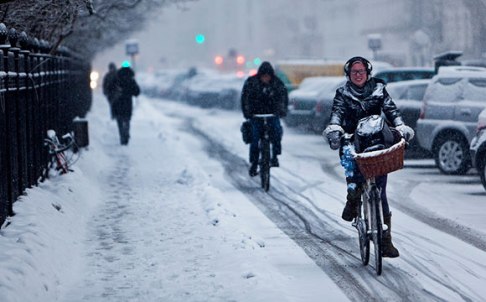Cultural Factors of Copenhagen
The cultural elements of language, institutions, material productions, and symbolic productions can be discovered in Copenhagen by way of the music, professional activities, art, services and religion.
Since music can be thought of as a language, I think it is appropriate to discuss the strong presence of music in Copenhagen. It is a big part of the Danish culture and as Benjamin Lee Whorf believed it does structure “our social behaviors.” For example, the Friday Rock at the Tivoli Gardens has become some what of a tradition amongst Copenhangers (visitcopenhagen). The link below showcases the assortment of musical venues and the wide variety of music one can experience in Copenhagen.
http://www.youtube.com/watch?v=tXjMmSnoG2w
As in the United States and other contemporary cultures, the people of Copenhagen also find that “play” has become an important aspect of their life. So much so, that the university has a class called The Culture of Play which discusses the upside and the downside of their “playful culture”. Video games, internet, movies, and advertising are some of the topics explored in the class (ciid). This learning is taking place in an educational institution. Hence, the institutions element of culture is present here.
For the material productions element I would like to touch on two factors that can be tied to Copenhagen’s culture, artistry and service. First, artistry is an important aspect of the Danish culture. The city of Copenhagen alone has more than 50 museums. Art from the Danish Golden Age are featured as well as art from Rome, Greece, and Egypt (48hourvisit). This shows that transmitting and improving the knowledge and skills of the community are important there.
 Ny Carlsberg Glyptotek (Photo by wjries)
Ny Carlsberg Glyptotek (Photo by wjries)
Secondly, Copenhagen has an intense bike culture. Bikes outnumber the residents of Copenhagen and fifty percent of them commute via a bicycle every day. Twenty five percent of families with two children in Copenhagen are likely to own a cargo bike (denmark.dk/en/greenliving) rather than an SUV or minivan. It would look a bit strange to most people in the United States to see a girl dressed up in stilettos riding a bike, but in Copenhagen this would be commonplace, even in the worst of weathers.
Follow the link below to see a young man from Copenhagen who has made a career out of repairing bikes for people who are on the go.
http://video.denmark.dk/video/1698729/0/the-bike-man-of-copenhagen
Christianity as a symbolic production has shaped the culture of Copenhagen and Denmark as a whole. The religion is so deeply ingrained in the society that one would be able to argue its roots go deeper here than in most countries. Communal institutions and attitudes have been fashioned by Christianity. However, today the religion only plays a circuitous role in the lives of the people. For the most part the religion only becomes apparent during events that surround a birth or a death (denmark.dk/en/society).
References
http://www.48hourvisit.com/copenhagen-arts-and-culture.html
http://ciid.dk/education/external-teaching/the-culture-of-play-copenhagen-university/
http://denmark.dk/en/society/religion/
http://denmark.dk/en/green-living/bicycle-culture/copenhageners-love-their-bikes/
http://www.visitcopenhagen.com/copenhagen/friday-rock-gdk474730
Features of Copenhagen Youth
There is only one person in my family who I can recall giving accounts about my heritage outside of the United States. Around the dinner table my grandmother would tell many great stories about her past. Danish family who live in Montana and her roots in Denmark would often come up. So, when I had to choose a region of the world in order to perform some analysis of that particular youth, I narrowed in on Copenhagen, the capital of Denmark. My thought was that this would be a great way for me to learn about an area of the world in which I have history. I will not be able to visit Denmark with my grandmother as we once discussed, but I have an opportunity to learn about a place that was important to her and attempt to discover current cultural trends of the region.
In my early research of Copenhagen, I discovered that people in Scandinavian countries such as Denmark continuously score the highest when rating overall happiness. The reasoning behind this has been the presence of a wide social safety net and the belief that they do not give in to the idea that material things bring happiness. Also, Scandinavia is 90% protestant. These facts may become important when assessing the cultural values of this region.
Narrowing my research further to the youth of this region, I found some generalizations and facts that were of interest to me. For starters, Copenhagen is often described as the world’s most bicycle friendly city. Bicycles are no less than an obsession with the people there. People are very liberal, but the breaking of rules is frowned upon. Besides discussing the weather, Danes are not interested in small talk and would rather remain quite than partake in meaningless conversation. The legal drinking age is 16 and young Danes are very skilled drinkers. Pork and potatoes are the staple foods of the region and Danes seem to enjoy bacon with everything (ah yes, a people after my own heart). They hold their architectural heritage in high regard, so design is important when decorating their homes. The Danish love lighting candles, even during the day. Fashion is important and the youth tend to be well dressed in stylish, but casual attire. The youth more or less listen to the same music, wear the same brands, and watch the same movies. Danes do not believe in superficial friendships, so it is not the easiest place to make friends. Students are generally in college for three years and they only take courses in their field of study. Lastly, Danish humor tends to be very dark so it is common to hear jokes that involve bodily harm and fluids. I believe it will prove to be most interesting for me to gather information on the youth attending gymnasium (our high school equivalent) and the younger college aged group, specifically the 16 to 20 year age group. Hence, I intend this to be my focus for the entirety of my blog.
References
http://www.disabroad.org/student-life/meeting-danish-students/



Recent Comments